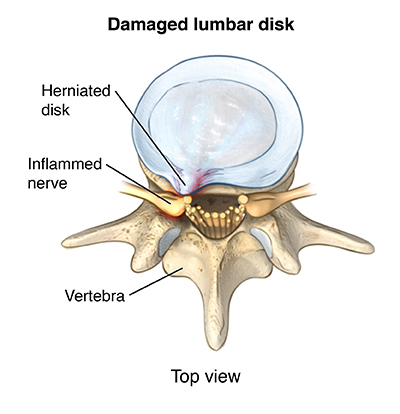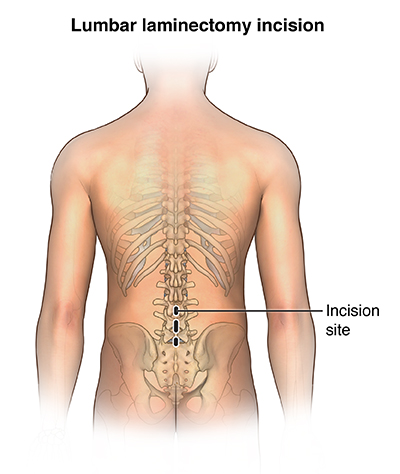What is a laminectomy?
Back pain that interferes with normal daily activities may require surgery for treatment.
Laminectomy is a type of surgery in which a surgeon removes part or all of the vertebral bone (lamina).
This helps relieve compression of the spinal cord or the nerve roots that may be caused by injury, herniated disk, spinal stenosis (narrowing of the canal), or tumors.
A laminectomy is considered only after medical treatments have proven to be ineffective.

Why might I need a laminectomy?
Low back pain can range from mild, dull, annoying pain, to persistent, severe, and disabling pain. Pain in the lower back can restrict your ability to move and function. Laminectomy may be done to relieve pressure on the spinal nerves, treat a disk problem, or remove a tumor from the spine.
One common reason for having a laminectomy is a herniated disk in the spine.

A disk may be displaced or damaged because of injury or wear and tear. When the disk presses on the spinal nerves, this causes pain, and sometimes numbness or weakness.
The numbness or weakness will be felt in the body part where the nerve is involved, often the arms or legs. The most common symptom of a herniated disk is sciatica (generally, a sharp, shooting pain along the sciatic nerve, extending from the buttocks to the thigh and down the back of the leg).
If medical treatments are no longer effective, back surgery may be an option. Some medical treatments for back pain may include:
Activity modification
Medication, such as muscle relaxants, anti-inflammatory drugs, and pain relievers
Spinal injections
Physical rehabilitation and/or therapy
Occupational therapy
Weight loss (if overweight)
Smoking cessation
Assistive devices, such as mechanical back supports
Laminectomy is usually done for back pain that continues after medical treatment, or when the back pain is accompanied by symptoms of nerve damage, such as numbness or weakness in the legs.
There may be other reasons for your healthcare provider to recommend a laminectomy.
What are the risks of a laminectomy?
As with any surgical procedure, complications can occur. Some possible complications may include:
Nerve or blood vessels in the area of surgery may be injured, resulting in weakness or numbness. The pain may not be relieved by the surgery or may become worse, although this is rare.
There may be other risks depending upon your specific medical condition. Be sure to discuss any concerns with your healthcare provider prior to the surgery.
How do I get ready for a laminectomy?
Your healthcare provider will explain the procedure to you and offer you the chance to ask any questions that you might have about the procedure.
You will be asked to sign a consent form that gives your permission to do the procedure. Read the form carefully and ask questions if something is not clear.
In addition to a complete medical history, your healthcare provider may perform a complete physical exam to ensure you are in good health before undergoing the procedure. You may undergo blood tests or other diagnostic tests.
Tell your healthcare provider if you are sensitive to or are allergic to any medications, latex, tape, and anesthetic agents (local and general).
Tell your healthcare provider of all medications (prescribed and over-the-counter) and herbal supplements that you are taking.
Tell your healthcare provider if you have a history of bleeding disorders or if you are taking any anticoagulant (blood-thinning) medications, aspirin, or other medications that affect blood clotting. It may be necessary for you to stop these medications prior to the procedure.
If you are pregnant or suspect that you are pregnant, you should notify your healthcare provider.
You will be asked to fast for eight hours before the procedure, generally after midnight.
You may receive a sedative before the procedure to help you relax.
You may meet with a physical therapist before your surgery to discuss rehabilitation.
Since certain activities may be restricted following your surgery, you will need to arrange for someone to help you for a few days with the household activities and driving.
Based upon your medical condition, your healthcare provider may request other specific preparation.
What happens during a laminectomy?
A laminectomy usually requires a stay in a comfort and recovery suite or a hospital. Procedures may vary depending on your condition and your doctor’s practices.
A laminectomy may be done while you are asleep under general anesthesia, or while you are awake under spinal anesthesia. If spinal anesthesia is used, you will have no feeling from your waist down. Newer techniques are being developed that may allow a laminectomy to be done under local anesthesia on an outpatient basis. Your doctor will discuss this with you in advance.

Generally, a laminectomy follows this process:
You will be asked to remove clothing and will be given a gown to wear.
An intravenous (IV) line may be started in your arm or hand.
Once you are under anesthesia, a urinary drainage catheter may be inserted.
If the surgical site is covered with excessive hair, the hair may be clipped off.
You will be positioned either on your side or abdomen on the operating table.
The anesthesiologist will continuously monitor your heart rate, blood pressure, breathing, and blood oxygen level during the surgery.
The skin over the surgical site will be cleansed with an antiseptic solution.
The surgeon will make an incision over the selected vertebra.
The surgeon will spread the back muscles apart.
The lamina (bony arch of the posterior part of the vertebra) is removed to relieve the pressure on the nerves in the area. This may involve removing bone spurs or growths, or removing all or part of a disk.
In some cases, spinal fusion may be performed at the same time. During a spinal fusion, the surgeon will connect two or more bones in the back to help stabilize the spine.
The incision will be closed with stitches or surgical staples.
A sterile bandage/dressing will be applied.
What happens after a laminectomy?
Recovery
After the surgery you will be taken to the recovery room for observation. Once your blood pressure, pulse, and breathing are stable and you are alert, you will be taken to your comfort and recovery suite or your hospital room. Laminectomy usually requires a stay of one or more days.
You will most likely begin getting out of bed and walking the evening of your surgery. Your pain will be controlled with medication so that you can participate in the exercise. You may be given an exercise plan to follow.
At home
Once you are at home, it is important to keep the surgical incision area clean and dry. Your healthcare provider will give you specific bathing instructions. The surgical staples or stitches are removed during a follow-up office visit.
Take a pain reliever for soreness as recommended by your healthcare provider. Aspirin or certain other pain medications may increase the chance of bleeding. Be sure to take only recommended medications.
Notify your healthcare provider to report any of the following:
Fever
Redness, swelling, bleeding, or other drainage from the incision site
Increased pain around the incision site
Numbness in your legs, back, or buttocks
Difficulty urinating or loss of control of your bladder or bowel
You should not drive until your healthcare provider tells you to. You should avoid bending over to pick up objects or arching your back. Other activity restrictions may apply.
Your healthcare provider may give you additional or alternate instructions after the procedure, depending on your particular situation.
Next steps
Before you agree to the test or the procedure make sure you know:
The name of the test or procedure
The reason you are having the test or procedure
The risks and benefits of the test or procedure
When and where you are to have the test or procedure and who will do it
When and how will you get the results
How much will you have to pay for the test or procedure